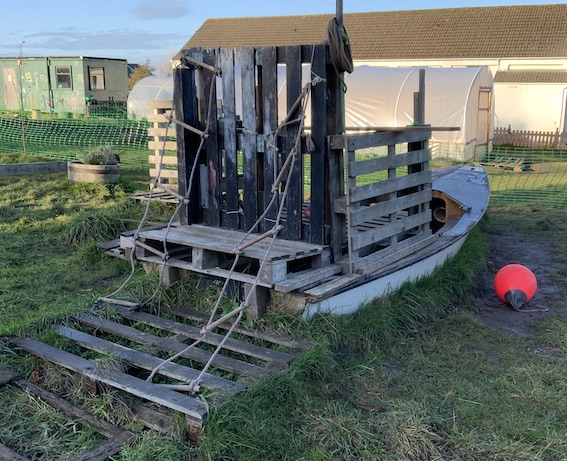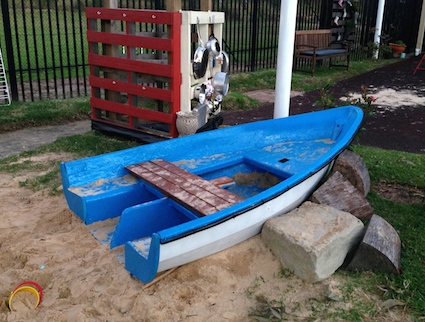In recent years, several schools and settings with whom I’ve worked, have managed to acquire a boat which quickly becomes a much-loved and well-used feature. So here’s some reasons why I think boats are brilliant…

1) Boats are often treasured by their owners
When they are no longer seaworthy, providing a retirement home in a school ground setting can renew their value and life in a different way. It’s an opportunity to extend the life of a boat that is no longer fit for its original purpose.

2) Generally boats are highly regarded by children for play purposes
They are great gathering places for chatting or imaginative play that often extends beyond ship-based activities such as playing pirates. In one school I visited, a small boat had been procured which was light enough for children to move around the grounds. It ended up in many different places according to how the children were playing.
3) Boats make great playspaces in their own right
Children end up using them in all sorts of ways. I’ve no idea why balls have ended up in the boat above. Loose parts and all sorts of items tend to be added, taken away and mixed into boat play.
4) Boats can have featured added to them
Below is the boat near the seashore in Aberdeen. I’m not sure who had the idea to create a specific play structure but this is quite a substantially-sized boat. Just imagine if the gang plank really did hang over the sea…
5) Boats can become shelters
This one is very posh. I think it could be a storage shed, but I’m not sure.
6) Boats can be a garden feature.
I’ve blogged before about this boat which now has a home at Inveraray Primary School. The grasses at the front represent waves. This photo was taken at the wrong time of the year – before replanting happened in spring time.

I spotted this beautiful feature at a road junction in Kent. It is a collaborative effort between different groups, businesses and folk in the village. Note the use of a rope as the border and the slates on the ground as the sea. The creel and net make a beautiful addition to the overall effect too.
7) Boats have a history
Any boat arriving in a school ground comes with a history. It may have been someone’s sailing boat, a fishing boat or something else. You can find out its name and history from the owner so that this can be celebrated, shared and remembered. There is a lifeboat – William Henry and Mary King – at Drayton Park School in Islington. Read the information about this boat and see how this is a much valued feature in the school grounds and local community. Best of all, every year the school holds a birthday party for its lifeboat in June.
How to find a boat
I’ve had a wee trawl on the internet for advice about using real boats for play purposes and very little exists. Most schools and settings with boats put a call out within their local area. Very often, it’s a parent, grandparent or other known adult who has an old boat somewhere that needs a good resting place. It’s also worth trying online social media forums as well as traditional notices in local shops.
Looking after the boat
It’s important to check the condition of a boat. If it is damaged, then repairs may be needed to make it safe for play purposes. Some schools remove oarlocks and any bits where the children may trap fingers or slip and land on something that sticking up or out. Broken fibreglass will need fixed and rotten wood replaced. Drainage needs to be considered otherwise the boat will fill up with water. This may include drilling holes and thinking about the surface underneath the vessel. Very often a local authority approved joiner can do this sort of work. If not, look online for a shipwright or boat builder. Most boats will need to be secured to the ground in order to keep them stable and to stop them from tipping over. Each setting will need to decide on the amount of gear left on the boat. For example some boats have various attachments such as rings and ropes. Decisions about the risks versus the benefits need a case-by-case consideration.
Eventually a boat may just degrade to the point where it is no longer useable. So have a discussion in advance about what happens to boats that reach this stage. Does your school or setting have the ability to safely move the boat on or dispose of it in accordance with your local and national waste regulations?
Making the boat accessible
Some schools may feel the need to add steps or a ramp up and into a boat to make it easier for a young child to access. However there is value in making access a rite of passage. For example, you know you are ready to play in the boat when you can get into it! At Crimmond School the boat arrived with a hole in the hull which is a secret entrance way into the boat for smaller children. Below is a lovely example a half boat which seems very user friendly.

Is a mast and sail necessary?
There are pros and cons to having a sail left on a boat. It can be a great opportunity for children to learn how to hoist the sail, and understand how it works before venturing onto water in a suitable boat. A mast and sail can look fetching and add value to imaginative play. Care will be needed as the sail can unexpectedly flap and bang into children, if not suitably secured. Also, a gust of wind can catch the sail and cause the boat to tip over. However tempting it may seem, children will have to know that the mast should not be climbed. In the photo below, Adventure Aberdeen have a high degree of supervision in their outdoor space and the staff are used to handling boats.
Alternatives to boats
A smaller option is to consider a canoe or kayak. Although similar installation and maintenance checks exist, they are easier to manage. They can also be more portable, so a kayak can be stored away if needed – or moved around a play space by children.
Finally, there is a detailed blog post mainly about pretend play boats in over at Playgroundology which gives various examples and a link to a heap of photos. We can continue to celebrate the contribution of boats to play and learning in school grounds and outdoor spaces… when are you getting yours?
This blog post was originally published in July 2012.




















Love this type of creative play. The KEEN Recess Team is always looking for new ideas on how to stay active outside.
Recess is a rallying cry for kids and adults to take a break from the daily grind, get outside, and create their own playground.
Thanks for the suggestions!
Best,
KEEN Recess Team
That`s a wonder full idea because the childrens are like the boat very much ,Boats make great playspaces in their own right Children end up using them in all sorts of ways
Thanks for such a interesting post
I’d love to put a boat in our playspace. I haven’t been able to locate one yet but I’ll keep looking 🙂